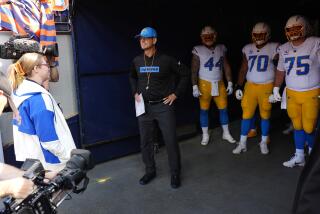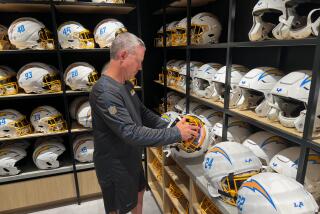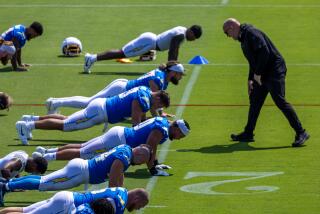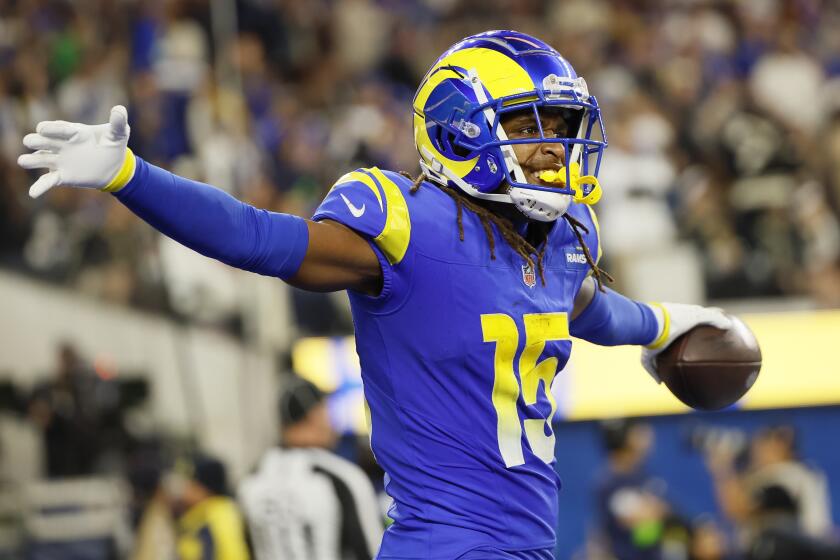The Go-To Guy
DENVER — The training room is off limits to outsiders, an inner sanctum where combatants are patched, primed and prepped for the next collision.
A professional football game lasts a little more than three hours, but this is a taken-for-granted seven-day operation, which goes a long way toward determining who wins and who loses.
Steve Antonopulos, a.k.a. “the Greek” and considered by many of his peers as tops in his profession, has worked for coaches Red Miller, Dan Reeves, Wade Phillips and Mike Shanahan as the Bronco trainer the last 24 years, applying miles of tape to players such as John Elway and Keith Uecker, the future Hall of Famer and old what’s-his-name.
He’s now supervising the rehabilitation of Terrell Davis and eight other injured Broncos, their full recovery critical to Denver’s chances of once again contending for the Super Bowl.
Recently Antonopulos offered a detailed look into the ice-pack world of the NFL, recounting the typical week for a trainer and the dynamics surrounding today’s athlete and the changing game he plays.
GAME DAY
It begins at 8 a.m. in Mile High Stadium for a 2 p.m. game, Antonopulos and his two full-time assistants operating like a MASH unit making ready for the arrival of casualties.
The players begin arriving at 10.
“We have three people hired to give massages,” Antonopulos says. “We’ve carried one guy with us for about five years, but it’s gotten really carried away the past three. We’re in a feel-good society and most of these guys have come through that, so it makes them feel good. And if it makes them feel good, then we’re all for it. It both relaxes them and helps in the stretching process.
“We’re not talking full-body massages here, but I would say about half the team has some kind of work done on some part of their body.”
Before the last group of players leaves the locker room at 1:20 for warmups, everyone needing ankle taping must be accommodated.
“We did a study two years ago and about 98% of the players were taped for a game and 60% for practice,” Antonopulos says. “It’s probably less than that now because a lot of guys are wearing ankle braces and some actually tape themselves. At this level, everybody is a little different and it’s such a psychological thing. Our old-time center, Billy Bryan, used to have to have his name on top of the taping list and then No. 7 [Elway] next to him.
“After Bryan left, we did it in chronological order and you always knew Elway would be first, and then Gary Zimmerman, Brian Habib. . . . But players are different now and don’t seem to care that much and we’ve stopped even putting up a list.”
When the game starts, Antonopulos stations himself at the ball along the sideline with a staff assistant to his side. If a player is injured on the field, he and his assistant are joined by a team physician, while another assistant steps on the field ready to receive signals from Antonopulos if additional equipment or attention are required.
“We had a guy down on the field telling me, ‘I’m OK, I’m OK.’ Well, sometimes you have to get strong and say, ‘Shut up, let’s take care of it and then we will let you up.’ It’s an anxiety situation when a player gets hurt on the field, whether it’s catastrophic or minor bruising, and the first thing that has to be done is to calm them down.
“When a guy comes to the sideline and I think something has happened, I’m going to him whether he wants me to know he’s been hurt or not. I’m all for them, and if they want to play tough guy, I’m going to roll along with them.”
Standing on the sideline, Antonopulos had an up-close and personal look at Elway, and while fans followed the flight of the ball down the field, Antonopulos’ eyes stayed on Elway.
“Whenever he got hit, I always watched to see if he got up.”
In the movie version, the player gets hurt and everyone expects him to take a shot for the team and return to the field, dragging his leg behind, if necessary.
“I remember when I first came to the Broncos, we went to another city and they told us the team that had just left had 43 syringes lined up,” Antonopulos says. “But those were the olden days. Things have changed drastically, and doctors are not going to infringe on their own ethics.
“In a year’s period of time we may give five or six injections. Most injections are therapeutic for after the game. You inject a certain area to let it calm down, for example a quad or hamstring or hip pointer. You can break up that pain-spasm cycle and then two days down the line you’re further ahead in dealing with treatment.”
At halftime on a good day, while coaches make offensive and defensive adjustments, Antonopulos, his staff and the team’s consulting physicians sit and drink coffee.
“But there are days when we have about five guys going, there’s such a shortage of time and the coaches want to know whether they can depend on any of them in the second half.”
Who makes the call whether a player will return to the game? The coach? Medical staff? Player?
“There are some things cut and dry, so you are going to stay here in the locker room, ice and elevate, then you’re going to go shower and we’re going to have someone stay here with you to make sure everything is all right. Now if there’s a question mark, OK, let’s see how you look on the sideline and your body will tell us if you’re capable of performing up to the level that’s needed to help the team.”
After the game, every player who has been hurt in any way is expected to report to the training room.
“We have a group of doctors--two orthopedists and a general medical doctor--who are with us on the road and at home. We have to know the status of what is going on for the next game right away, and we have on-site X-ray at the stadium, so let’s get that done.”
There can be as many as 20 players walking out of the locker room after a game with ice packs still attached to their bodies, Antonopulos says.
“But the old days when people used to say, ‘I spent all night getting treatment, is nonsense.’ You can only give so much treatment, and part of the treatment is mental, and if someone’s hurt and going through a traumatic thing, they need to be with their family.”
A little after 6:30 p.m., 10 1/2 hours after having been one of the first to arrive at the stadium, Antonopulos is one of the last to leave.
MONDAY
It’s 5 a.m., and Antonopulos is already behind his desk. This is his quiet time, when he does all the paperwork now required because of the growing number of injury grievances and disability claims filed by players at the ends of their careers.
“You document everything now. A guy has a hangnail, I document that,” he says. “I have one guy, and that’s all he does--he inputs into the computer all morning. He helps in the training room, but that’s his primary responsibility, keeping up with the paperwork.”
The first players requiring medical treatment arrive at 7, the team’s doctors report at 9 and the Broncos block out time each Monday morning at a local hospital for diagnostic tests in case they are needed.
“One of the great things about winning, we can keep a player in treatment for six to eight hours if we need to,” Antonopulos says. “If we have lost, the players are required to go to meetings beginning at noon, so we will do the diagnostic work in the morning and then bring them back for treatment late in the day.”
With all the planning and strategy that go into preparing a team for a game, can a trainer tell on Monday whether a coach will have an injured player ready to go the following Sunday?
“That’s one of the things we try to do from the time the game ends on Sunday and through the Monday process until I meet with [Coach] Mike Shanahan around noon. When I go see him with the list of players, I try to lay it out with how much practice time a player will miss, and I want him to know whether that player will be there for him or not at the end of the week.”
What about sports’ lore, an injured player saying, “I’ll be ready to go, coach,” the week of a big game?
Antonopulos laughs.
“We have to bring reality to it.”
TUESDAY
Another day beginning at 5 a.m., although it is the players’ day off.
Injured players, however, must report for treatment or be subject to hefty fines.
There seems to be a perception that the injured athlete is under constant pressure to return to the field, but those were the old days, Antonopulos says.
“The salary cap has changed the mind-set about playing at all costs. The body is more prized now because of that salary cap. If you lose a player for a longer period of time, it’s going to seriously hurt you as an organization. You have some coaches who might say, ‘I can’t believe this person can’t play with that--I remember such and such did it 20 years ago.’ But it’s different now, and coaches who say that run out of players and aren’t around very long.
“It’s not like you think--at this level you don’t have players wanting to be in there just because the team’s winning. If a guy is hurt, he’s hurt and he has a career to think about. They are going to take care of themselves.”
The image of players sitting the day away in a hot tub or whirlpool, however, is misleading. There’s no time. Today’s football player is involved in conditioning, lifting weights, or attending meetings.
“We have the hot tubs and the whirlpools if a guy wants to use them for recovery purposes, but all that has dwindled over the years.”
WEDNESDAY AND THURSDAY
Antonopulos is at work at 4 a.m., an hour earlier because the game is getting closer and the tension to be ready increasing.
“We also have one player who comes in at 6:15 because he needs a little extra loving. . . . Everyone is in by 7 for treatments, and when the meetings begin at 9, the long-term rehabs come in.”
A check of the left corner of Antonopulos’ desk reveals how the Broncos are faring. One folder, as was the case the last two years, and they are on their way to the Super Bowl. Nine, like this year, and they are out of the playoffs.
“We have a folder for each player who is out for the year and undergoing rehabilitation. I [hand] write out a plan for each injured player out for the year every morning, a flow sheet, and then assess their progress in writing at the end of each day.”
It sounds so formal, but it belies the time and energy required to work an athlete through his injury. The day-to-day work is geared toward Sunday success, but a season-ending disaster strikes at the short career span of these athletes and requires incredible emotional support as well as medical expertise.
“Everyone is different in their needs,” Antonopulos says. “You take Terrell Davis, if you don’t write down in his folder that he did great, it ticks him off to no end. ‘What do you mean I didn’t dominate?’ So now I write in there every day, ‘You dominated in today’s work.’ These guys are meticulous in everything, they are afraid to fail and they don’t want negativism. It’s all about winning and in order to win, you have to be positive. Even if someone is not doing great in rehab, you have to find something to be positive. Sometimes I’m strict with them, but never negative.”
Four Broncos were sidelined this season because of torn knee ligaments, making the training room look like a testing lab for all kinds of knee contraptions. When Antonopulos began work with the Broncos, it took major surgery to open a knee and repair it, which lengthened and complicated the rehabilitation process.
Now, arthroscopic procedures have reduced the surgical trauma, allowing for earlier and more intense rehabilitation. On another side of the trainer’s desk, a pile of seminar brochures and literature highlighting the advances in medical care suggest there will never be enough hours in the seven-day week to keep up.
“When a player gets hurt, we give them a window of, say, four to six weeks before they will return,” Antonopulos says. “And when the player says, ‘I’ll be back in three,’ OK, great, we’re on your side and when you’re back in three weeks these are the things you will have to look at as far as potential risk goes. You never shut anyone down.”
Two years ago, San Francisco 49er wide receiver Jerry Rice was determined to return from a knee injury faster than anyone else, and did so before re-injuring his knee late in his first game back.
“There’s a healing timeline that doesn’t really change for anyone. When Terrell Davis got hurt, he said he wanted to be the fastest rehab guy ever. And he has been, and I’m letting him go as fast as he can. He could have come back in three months, potentially for the end of this season, but he could have screwed up the graft or loosened it, and we know research shows that graft won’t be solid for six months. You’re better off waiting six months because Terrell Davis is going to be here five years down the line.”
There is nothing gentle in the wait, however. It’s not unusual to hear an athlete cussing out the team’s trainer, sincerely believing that he is being pushed beyond the pain anyone else could possibly endure.
“We’re gonna push them, and push them to the limit as opposed to the recreational athlete going down the street for treatment. We’re going to push them, because you can push them, because they are special. They are elite athletes at a different level from anyone else. We can far exceed any protocol any doctor would give them because of their musculature, their [sensory] values and their neuromuscular skills. They are just phenomenal and, to be honest, sometimes I don’t even realize it.”
After meetings, the players go onto the field at 11:15 for a walk-through practice, and Antonopulos is there. During lunch, players report for taping, with those requiring treatment doing as much as they can before the start of practice at 1:30.
After practice, there is half an hour more of treatment, meetings with position coaches and then back to the training room for more treatment.
Sometime between 6 and 7, Antonopulos makes his way home, taking a short respite before returning once again at 4.
FRIDAY
The day begins like the previous two, but this one is condensed. There will be no lunch, no breaks, and a chance to be on the way home before 4.
“It’s a grind, but a grind I like. I don’t count how many hours I work, how many ankles I tape, or how many days until the end of the season.
“I’m living a dream. I grew up in a small town of 800 people in eastern Colorado and I always wanted to be a doctor. But once I decided I would become an athletic trainer, I wanted to be the trainer for the Broncos. Not many people get to live their dream. My wife has a job where she sits at a desk for 10-12 hours a day.”
SATURDAY
If it’s a weekend for a home game, there will be a chance to get away by noon after treatments, a walk-through practice and more treatments.
“I don’t believe there are any more injuries in the game than what we have had in previous years,” Antonopulos has concluded. “There is a perception that there are more, but that’s because of the awareness today. For example, there seem to be more concussions because now we have a system in place to report them. But when I think back to Elway’s first few years and how many that guy had, well, nothing has really changed.”
The argument, however, is that players have become bigger, faster and stronger, making the collisions more colossal than ever before.
“But today’s players have more elasticity in their joints, their structures are stronger, their [sensory] values better, and with all those things, it helps them to better prevent injuries.
“We’ve done a study since I came here on the types of injuries we have--sprains, strains, contusions--and divide them up on the part of the body impacted. And every year it’s the same. One year we may have more sprains than strains, but it all evens out. The NFL has done similar studies, and the results have been the same.”
Antonopulos also disputes the popular theory that artificial turf heightens an athlete’s chances of getting hurt.
“I used to believe that. It was a mind-set, and I used to think, ‘Let’s just get through this game without anyone getting seriously hurt.’ The players feared it, so did the coaches and we didn’t win on it.
“But if you look at the teams that practice on it and play on it every day, they have as few injuries or less than what we might have. When you forget about the surface, just go play and win, it seems like you have the same amount of injuries as when you don’t play on it.
“There are some injuries related to artificial turf, like toe injuries and the potential for more concussions. But the traction thing, no, I don’t buy into that anymore. What I do buy into is the fact that older guys practicing on grass all week and then playing on artificial turf, it seems to put stress on their joints. And with some of the degenerative joint changes that these guys have undergone, it takes them longer to recover.”
GAME DAY
The circle comes complete, only to be redone.
“When the game is over, I know this,” Antonopulos says. “I know my wife will be waiting for me outside the stadium to take me home. Everyone else has gone, but she will be there with a nice little kiss.”
Just what the doctor ordered.
More to Read
Go beyond the scoreboard
Get the latest on L.A.'s teams in the daily Sports Report newsletter.
You may occasionally receive promotional content from the Los Angeles Times.










